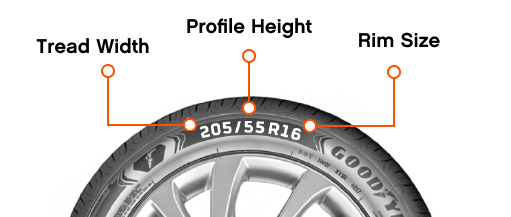Our Story
Always looking to maximise driving pleasure, Dunlop offers all types of motorists and riders the performance and durability of the latest tyre technologies. Dunlop's Touch Technology reflects the company's product development approach: Dunlop tyres help drivers to have an enhanced feel of the road providing superior road feedback, to be more in control of the drive and due to that to have more driving fun.
Dunlop is one of the world’s leading manufacturers of high and ultra-high performance tyres with prestigious original-equipment fitments: Many of the most prestigious car makers fit Dunlop tyres as standard, including Alfa Romeo, Audi, AMG, Aston Martin, BMW, Honda, Jaguar, Mercedes-Benz, Mitsubishi, Nissan, Opel/Vauxhall, Peugeot, Porsche, Renault, Rover, Seat, Skoda, Toyota and Volkswagen. Dunlop is supplying motorcycle tires as original equipment to leading motorcycle manufacturers, including Aprilia, Benelli, BMW, Buell, Derbi, Ducati, Harley Davidson, Honda, HRD, Husaberg, Husqvarna, Kawasaki, KTM, MV Agusta, Peugeot, Piaggio, Suzuki, Vertemati, Yamaha.
Dunlop offers a range of more than 130 different commercial tires suitable for heavy trucks, buses and coaches. Also many top commercial vehicle manufacturers fit Dunlop tyres as standard, including Volvo, Renault, Scania, DAF, MAN, Daimler Chrysler and Iveco.
For over 130 years Dunlop has been a global tyre brand with its origins in the late 19th century and a fascinating history in New Zealand.
The Dunlop Rubber Company was founded by Scottish inventor John Boyd Dunlop in 1889. He was watching his young son riding his tricycle on solid rubber tyres over cobbled ground. To provide his son with a smoother ride and better handling, John Dunlop took the tricycle, wrapped its wheels in thin rubber sheets, glued them together and inflated them with a football pump. In this way he developed the first air cushioning system in history.
John Dunlop had invented the first practical pneumatic tyre and realised the commercial potential of his invention. He patented his design and established the Dunlop Tyre Company to manufacture and sell his new product.
This led to the global expansion for Dunlop Tyres which included the first New Zealand Dunlop office opening in Christchurch in 1897, selling mainly cycle tyres and tubes. Dunlop Tyres NZ was a branch of Dunlop Australia until the rights were bought back by the English Dunlop company in 1929.
In the 1960’s a local manufacturing plant was established in Upper Hutt which went on to become New Zealand's leading tyre manufacturer. The plant also played a key role in the growth of New Zealand’s economy by manufacturing not only tyres but a range of other rubber products.
Dunlop’s success in New Zealand continued with the brand quickly becoming a household name. Dunlop tyres were used by some of the most famous motorsport champions in New Zealand, including Bruce McLaren and Chris Amon, who both won major races on Dunlop tyres.
In 2006 the Upper Hutt manufacturing plant ceased local production of tyres being imported from other countries including Australia.
Despite this, the brand's rich history in New Zealand has contributed to its enduring appeal and Dunlop remains a popular brand with Kiwi motorists who continue to stick with Dunlop.


Where We Are Today
By the start of World War II, Dunlop was the byword for success in a range of activities – not only tyres where it reigned supreme on and off the racetrack, but also brakes, wheels, golf and tennis balls, flooring, and other industrial rubber products. In 1984 came the consolidation of Dunlop’s European and US tyre operations with its Japanese business, as part of the Sumitomo group. In 1999 Sumitomo and The Goodyear Tire & Rubber Company decided on a global alliance, becoming the world’s biggest tyre producer. This continued until 2015 at which time Goodyear undertook ownership in Australia, Europe, New Zealand, and North America.
History of Dunlop in New Zealand
1897 - Dunlop opened its first office in New Zealand, based in Christchurch selling mainly cycle tyres and tubes. Dunlop NZ was a branch of Dunlop Australia until the rights were bought back by the English Dunlop company in 1929.
1937 - The head office moved to Wellington and the company was granted the right to establish a factory in Christchurch to manufacture rubber ware for the dairy industry, cycle tyres, retread rubber, battery boxes and hot water bottles.
1946 - The company "Dunlop New Zealand Limited" was formed
1949 - New tyre manufacturing factory established at Upper Hutt producing car, truck, tractor and small earthmover tyres, supplying the growing car assembly industry and providing tyres for the major hydro electrical, highway and other construction projects of the time. Dunlop also produced tyres for Goodyear under contract.
Mid-1960s - New technology saw the introduction of the radial ply tyre and the advent of the SP 49, and then the famous Dunlop Aquajet.
1966 - Dunlop NZ entered the retread business. Four years later bought Reliance Tyre & Rubber Company, providing additional retreading factories and an entry into tyre retailing. By the end of the 60's Dunlop NZ were involved in the manufacture of a range of other products including rubber mattresses, golf balls and sporting equipment and bought a small foundry making moulds for the NZ retreading industry
1978 - The first Upper Hutt manufactured steel radial tyres sold
1983 - Industry restructuring saw the acquisition of Reidrubber including its aero retreading plant in Christchurch.
1984 - Australian company Pacific Dunlop Ltd took over the New Zealand business from its UK parent and minority shareholders.
1987 - The South Pacific Tyres joint venture between Pacific Dunlop Ltd and Goodyear Tire and Rubber Corp of the USA was formed. Dunlop New Zealand sold its non tyre businesses to Pacific Dunlop and joined with Goodyear NZ to form South Pacific Tyres NZ Limited.
2006 - South Pacific Tyres ceases production of new tyres in New Zealand, Upper Hutt Factory closes.
Dunlop tyres are now manufactured around the world and imported into New Zealand from countries like Australia. Goodyear and Dunlop Tyres New Zealand continue to support and distribute Dunlop tyres throughout New Zealand.
Dunlop's history is rich with important innovations that have improved the driving experience for everybody on the road. If the discovery of the aquaplaning phenomenon, the invention of "fail safe" tyres, and the introduction of the 3S-technology stand out as highlights, Dunlop is proud of numerous other inventions during the past 100 years that have made the driving experience a better and more enjoyable one for every driver.
- 1922 Development of the first Dunlop steel bead tyre with a woven cord casing trebled tyre life. Together with the well base, single piece wheel this became the industry standard.
- 1948 Dunlop introduces a tubeless tyre with a plastic self-sealing layer on the inner surface casing. This coating prevented loss of air in case of tyre damage. By 1954, when further development rendered the sealant layer unnecessary, it was estimated that the number of punctures causing road delays had been reduced from one in 16,000 miles with tubed tyres, to one in 80,000 miles on tubeless ones.
- 1959 Dunlop introduces the first tyre (RS5) incorporating an intensive knife-cut tread pattern, a nylon casing (for strength and resistance at high speed), and the safety shoulder developed by their engineers in Germany.
- 1962 - 1964 Dunlop’s technical team discovers a phenomenon unexplained until then - aquaplaning. Their demonstrations of this phenomenon caused a worldwide sensation and led to numerous awards for the Dunlop team. The subsequent pattern patents (introduced as SP 68) ensured that from then on tyre pattern development was focused on the few square inches of tire at ground contact. The density of knife-cuts in the tread surface was dramatically increased, and a new feature known as 'aquajets', which can be described as tunnels through the side ribs of the tread, enabled water to be ejected sideways.
- 1972 World innovation: Dunlop develops the first 60 series steel belt tyre
- 1973 World innovation: Dunlop launches DENOVO, the first ‘fail-safe’ wheel/tyre system. Legislation is changed to allow it to be used on the road, and by 1973 it was OE fitment on the Mini 1275GT.
- 1979 Dunlop introduces the Denloc bead locking system as an integral part of the DENOVO 2 system.
- 1983 Dunlop presents the TD/Denloc safety and ’fail-safe’ system.
- 1994 World innovation: Dunlop presents the first ultralight construction belt tyre. It reduces the vehicle weight by about 12 kg. Development of the Instant Mobility System (IMS) as a substitute for the spare wheel - in case of a puncture a latex compound is injected into the tyre sealing it.
- 1997 Dunlop introduces the high-performance tyre SP Sport 9000, a completely new profile technology.
- 1998 Development of the DSST (Run Flat) tyre, a self-supporting tire with ‘fail-safe’ characteristics.
- 1999 The tyre monitoring system WARNAIR is introduced. It quickly detects air pressure loss and indicates this to the driver either by an audible or visual warning.
- 2002 Dunlop introduces the 3S-technology. An innovative asymmetrical tri-area tread is the basis of tyres born to equally unite the aspects of Silent running, Sportiness, and Safety.


Lorem ipsum dolor sit amet, consectetur adipiscing elit, sed do eiusmod tempor incididunt ut labore et dolore magna aliqua. Ut enim ad minim veniam, quis nostrud exercitation ullamco laboris nisi ut aliquip ex ea commodo consequat. Duis aute irure dolor in reprehenderit in voluptate velit esse cillum dolore eu fugiat nulla pariatur. Excepteur sint occaecat cupidatat non proident, sunt in culpa qui officia deserunt mollit anim id est laborum.


Lorem ipsum dolor sit amet, consectetur adipiscing elit, sed do eiusmod tempor incididunt ut labore et dolore magna aliqua. Ut enim ad minim veniam, quis nostrud exercitation ullamco laboris nisi ut aliquip ex ea commodo consequat. Duis aute irure dolor in reprehenderit in voluptate velit esse cillum dolore eu fugiat nulla pariatur. Excepteur sint occaecat cupidatat non proident, sunt in culpa qui officia deserunt mollit anim id est laborum.
Lorem ipsum dolor sit amet, consectetur adipiscing elit, sed do eiusmod tempor incididunt ut labore et dolore magna aliqua. Ut enim ad minim veniam, quis nostrud exercitation ullamco laboris nisi ut aliquip ex ea commodo consequat. Duis aute irure dolor in reprehenderit in voluptate velit esse cillum dolore eu fugiat nulla pariatur. Excepteur sint occaecat cupidatat non proident, sunt in culpa qui officia deserunt mollit anim id est laborum.






